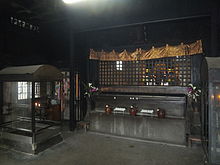Sōfuku-ji (Fukuoka)

The Sōfuku-ji ( Japanese 崇 福寺 , literally the temple of sublime happiness) in Fukuoka (Japan) is a Buddhist temple of the Rinzai school ( Rinzai-shū ). It was founded in 1240 at the seat of the Dazaifu special administration by the monk Tan'e ( 湛 慧 ). In the following year the monk Enni Ben'en ( 円 爾 弁 円 ) , who had also returned from China, gave the inauguration sermon. Together with the Jōten Temple ( 承天寺 , Jōten-ji) built in Hakata in 1241 , he was under the control and protection of the general Mutō Sukeyori (1160-1228), who resided in Daizaifu as a representative of the Kamakura shogunate .
During the Azuchi Momoyama period , the facility burned down in 1586 during fighting between the Shimazu clan and the Ōtomo clan . With the establishment of the fief Fukuoka (Fukuoka- han ) by the commander Kuroda Nagamasa (1568-1623) in 1600, this was the temple as a family temple in Hakata again build.
When building the castle town of Fukuoka, materials from older buildings and facilities were used. A "China Gate" ( Karamon ) called gate comes from the Najima Castle ( 名 島城 Najima-jō , Najima-jō ), which is located on a headland and was demolished in 1601 because the surrounding area was insufficient for the development of a larger settlement. Many stones were used in the new Fukuoka Castle.
During the suppression of Buddhism and its separation from Shinto ( Haibutsu kishaku ) in the early Meiji period , the facilities fell apart. Reconstruction began in 1895. In 1918 the main gate of Fukuoka Castle was implemented and has since served as a temple portal ( Sanmon , literally "mountain gate ").
In 1945 the city of Fukuoka was bombed again by the US Air Force. Among other things, the famous tea room of the merchant and tea master Kamiya Sōdan (1551-1635) went up in flames.
After the war, the remaining burial grounds of the Kuroda rulers were restored and concentrated on a fifth of the former area.
In 2005 three buildings were lost to fire.
In 2014 the Kuroda family handed over the remaining Kuroda graves from the Edo period to the city of Fukuoka. In the same year the short stairway ( sandō ) was extended from the street to the temple portal. The devotional items shops were also reduced and implemented.
On the inside of the outer wall in the publicly accessible front temple area there is a long, covered walkway with hundreds of large and small statues from many different Buddhist denominations that were deposited there by believers.
Significant burial sites
In addition to the members of the Kuroda dynasty, other personalities of regional and supra-regional importance found their final resting place in the cemetery of the Sōfuku Temple, such as the trader and tea master Shimai Sōshitsu (1539–1650), the male-educated ophthalmologist Takaba Osamu (1831–1891 ), who exerted a great influence on numerous personalities of the Meiji period through their "ginseng field school" , also the first president of the Fukuoka Medical School Ōmori Harutoyo (1852-1912) and members of the nationalist organization Gen'yōsha such as Tōyama Mitsuru and Kurushima Tsuneki.
literature
- Heinrich Dumoulin : History of Zen Buddhism . Volume 2: Japan. Francke, Bern and Munich 1986 (reprint 2nd edition, Francke, Bern and Munich 2014, ISBN 978-3-7720-8516-1 )
- Andrew Cobbing: Hakata - The Cultural Worlds of Northern Kyushu . Brill, Leiden 2013.
Web links
- Website of the Kyushu National Museum with a plan of the old temple complex and a statue of the founder Tan'e (Japanese)
Remarks
- ↑ More in Dumoulin, Vol. 2
- ↑ More on Mutō: Samurai Wiki
- ↑ Cobbing, p. 47ff.

